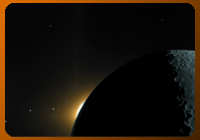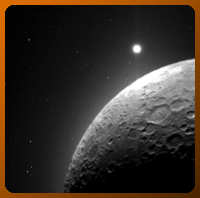You are seeing this message because you are using an out-of-date browser.
Please click here for more information.

Image courtesy of: JPL/NASA
Our home planet has only one moon, but it is a significant element of our everyday life. From our calendar, which is loosely based on the phases that the Moon goes through, to all the superstitions that are based on the phrase "It's a full Moon" on to the impact that the Apollo space program had on all our lives, the Moon affects us in ways that we take for granted.
In addition to the social and cultural impact that the Moon has on all of us, it has a daily physical impact on those people that live near large bodies of water. The Moon and the Sun are responsible for the daily high low tides of the world's oceans.
A Dragon is Eating the Sun!
One of the sky's most impressive shows occurs when we have either a lunar or solar eclipse.
A solar eclipse occurs when the Moon passes in front of the Sun and a lunar eclipse happens
when the Moon passes through the Earth's shadow. Until astronomers found out that eclipses
could be predicted, people usually thought that an eclipse was an omen
that something bad was about to happen. Among the things that people believed was that a
dragon, or some other dreadful creature, was actually devouring the Sun! Fortunately, we
have learned that eclipses are something to enjoy rather than fear.

Image courtesy of: JPL/NASA
One of the most interesting questions scientists have studied over the years is "Where did the Moon come from?". There have been many theories throughout history, ranging from mythical explanations to one that says the Moon is an asteroid that was captured as it flew by our planet. The currently accepted theory is that our Moon was formed when a body of some kind hit our planet approximately where the Pacific Ocean is now. The impact was so violent that a piece of our planet was torn away and eventually became the Moon that we are familiar with now.

Image courtesy of: JPL/NASA
The other result of these many impacts are what ancient people thought were oceans on the surface of the Moon. The large dark areas that do look a little like bodies of water from here on Earth are actually large areas that were once molten rock that cooled off and made the relatively large, flat areas that we see today. The most famous of these "oceans" on the Moon is the Sea of Tranquility, which is where the Apollo 11 astronauts landed.
The Dark Side of the Moon
Among the more persistent myths about the Moon is the one about the Moon having a "dark"
side. If you have spent any time at all watching our Moon, you undoubtedly will have
noticed that our view of it doesn't change. We can always see "the Man in the Moon"
assuming that the Moon is full enough. To a casual observer, this might mean that the Moon
doesn't rotate. The facts are that the Moon does rotate on its axis just like Earth
does. The suprising fact is that the speed of the Moon's rotation is such that it
always shows us the same view. Half of the Moon is always illuminated just like half
of Earth is always illuminated. The Moon has "days" just like Earth does, which means
that there is no side of the Moon that is always dark.
Once in a Blue Moon
One of the folk sayings that has persisted in our culture is "Once in a Blue Moon", which
is an old-fashioned way of saying that something doesn't happen very often. This phrase is
another example of how the Moon affects our everyday culture. During a normal month, we will
have just one full Moon. One very rare occasions, however, we get treated to two full Moons
on a month. The second full Moon is called a Blue Moon, so we have come to use the saying
"Once in a Blue Moon" to refer to something that doesn't happen very often.

